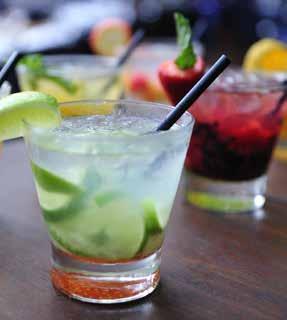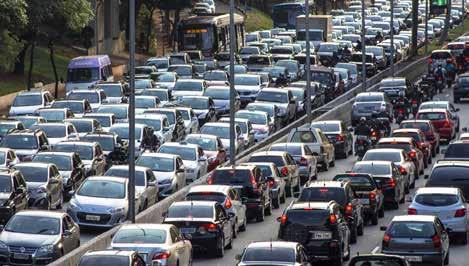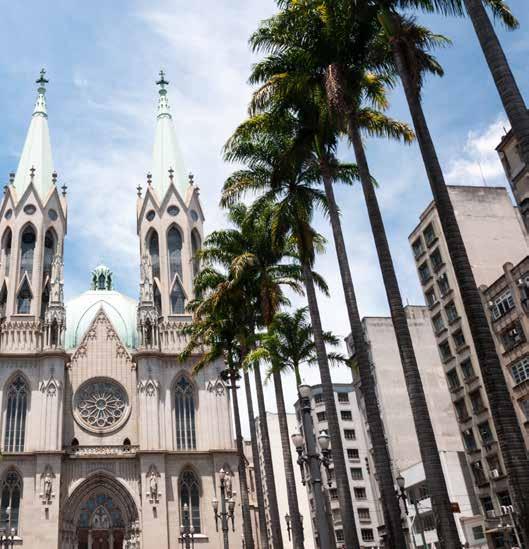
6 minute read
São Paulo
from Upgrade Issue 8
DOING BUSINESS IN
São Paulo
Advertisement
São Paulo is the commercial hub not just of Brazil, but of Latin America. If it were a country its GDP would rank it as one of the largest in the world.
The ex-Portuguese colony’s huge coffee export income has enabled it to grow into a wealthy industrial city, and now it's following the global trend into services. International law, consulting and financial services are all strongly represented, too.
GETTING THERE
There are very few non-stop flights between the UK/Ireland and São Paulo. Oneworld partners Latam and British Airways both have a daily flight from Heathrow, as does Virgin Atlantic through its Brazilian codeshare partner GOL. A connecting flight will be required if any other carrier or UK or Irish airport is used.
The centre of São Paulo is about 15 miles southwest of Guarulhos (GRU – the international airport), so a taxi or airport transfer should be organised. STAYING THERE
Traffic in São Paulo is so heavy that taxis can sometimes take an hour, so it’s vital for the hotel to be close to the intended meeting.
First impressions are important in Brazil and businesspeople are judged not just by their dress but by their accommodation.
Business hotels are plentiful around Avenida Paulista and in the districts of Jardins and Itaim Bibi, which are also home to some of the city’s finest restaurants.
Located in downtown Brooklin, São Paulo’s new commercial district, the Grand Hyatt São Paulo is close to Itaim Bibi and Congonhas (the domestic airport) and has panoramic city views and two international restaurants.
The Hilton São Paulo Morumbi is situated inside the CENU Complex, close to Berrini Avenue, WTC Convention Center and Berrini rail station. The city’s skyline can be admired from most of the guestrooms and there are stunning views of the Ponte Estaiada suspension bridge from the top floor’s swimming pool and fitness centre. Hotel Emiliano, a boutique hotel on Rua Oscar Freire, one of São Paulo’s most stylish streets, has many sophisticated features. These include a fully-equipped spa, a vertical garden, a champagne bar and even a rooftop helipad.
The Renaissance São Paulo, also close to a metro and Avenida Paulista and Rua Oscar Freire, has the bonus of two betterthan-hotel-average restaurants: Terraço Jardins features Brazilian cuisine with local ingredients from small producers, or Living Lounge Bar & Sushi for Japanese food.

São Paulo is a huge melting pot. With many of its population having Italian or Japanese roots, there are many Italian and Japanese restaurants. Latin America has also become something of a foodie heaven and São Paulo has many creative chefs and restaurants eager to showcase local products.
The Jardins restaurant D.O.M. has two Michelin stars and has been a stalwart on the world’s ‘bests’ lists. It’s famous for rock star chef Alex Atela (literally, as he is an ex-DJ) and a multi-course tasting menu with Amazonian ingredients, including ants and Brazilian seafood such as Santa Catarina oysters.
Mani’s head chef, Helena Rizzo, and her contemporary Brazilian-European fusion dishes are regulars on Netflix’s The Final Table. Her tasting menu can be sampled in this former residence in Jardin’s leafy Jardim Paulistano neighbourhood.
Carnivores who don’t want to linger over a Michelin-starred meal but find themselves in Republica should visit A Casa do Porco, a bar which, as its name suggests, is a temple to imaginative, notbreaking-the-expense-account creations from bacon, sausage and ham.

The Riviera Bar is for those who want to sip their caipirinhas somewhere with history. This home to musicians and leftwing intellectuals, particularly during Brazil’s military dictatorship throughout the 1960s, 70s and 80s, on Avenida Paulista and Rua da Consolação, reopened a few years ago as a much larger – and smarter – bar with superb cocktails.
And if you’re a footie fan, try São Cristovado in Vila Madalena, a temple to Brazilian football.

GETTING AROUND
Traffic is heavy in the city, so by day the best way to get around São Paulo is on foot or via metro. At night, taxis or Ubers are the better option.
The São Paulo metro operates six colorcoded lines that are also numbered. The routes typically move north and south, and east and west. The metro runs from 4.40am to midnight Sunday through Friday and to 1am on Saturday.
You can buy a bilhete unitário (single ride) or a reloadable bilhete único card which can be topped up as necessary at metro station kiosks.

DRINKING
Close to the Avenida Paulista, inside the Maksoud Plaza, is the very cool and classy Frank Bar. It was created as a homage to Frank Sinatra but the cocktails, both the classics and some imaginative modern inventions, are the star of the show.

Whether to describe its shape as a watermelon or an old ship is debatable - but the luxurious Hotel Unique’s rooftop Skye Bar is the place to sip a wasabi martini and share stunning views of the city.
Valquiria Mendes, National Account Manager, FCM Brazil

“If you stay in the central area the metro is an efficient way to get around São Paulo. But if you stay further away from the centre, definitely use a taxi or Uber - be aware that it is a city of intense traffic; it is always good to allow extra time and set off an hour in advance, because you never know what to expect.
“There are a lot of good bars and restaurants for business lunches, and for fun too. São Paulo is a 24-hour a day, 7 days a week city – there’s always something to do, some place to go.”
Neo-Gothic cathedral
BUSINESS CUSTOMS
f UK Foreign Office advice is to be wary of theft or pickpocketing around Avenida Paulista and the historical downtown area. It also warns that the red light districts located on Rua Augusta (north of Avenida Paulista), Catedral da Sé, Praça da República and the Estacao de Luz metro “can be especially dangerous”.
f Brazilians negotiate with people not companies - so first impressions and personal relationships are important. Men shake hands and women are kissed on both cheeks.

Ibirapuera Park
f Efforts to speak Portuguese are appreciated. When first introduced, it is polite to say “muito prazer” (my pleasure). Expressions such as “como vai” and “tudo bem” are used to say hello once you know someone.
f Business starts at 9am but many business meetings are held over a coffee in a coffee shop or restaurant. Decisions are rarely made after one meeting.
f Good conversation topics are football and family.
f The city’s trademark is heavy traffic, so punctuality is relaxed and being late by up to 15 minutes is acceptable.
TIME OFF
If you have any time off, just walk around the city. São Paulo’s amazing architectural history includes iconic buildings from its neo-Gothic cathedral to skyscrapers like the 1929 Martinelli and Oscar Niemeyer’s curvy Edifício Copan. The colonial-style Pátio do Colégio church marks where Jesuit priests founded the city in 1554.
As well as being South America’s largest urban park, Ibirapuera Park is also home to several museums including the Museum of Modern Art.
Renaissance São Paulo hotel







